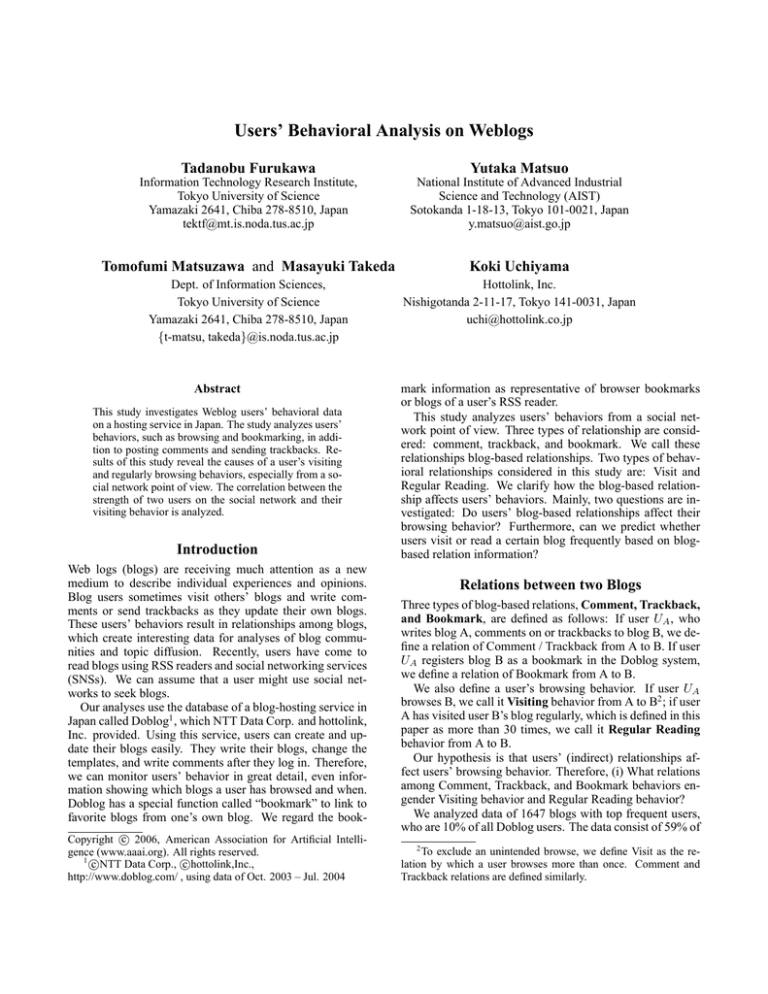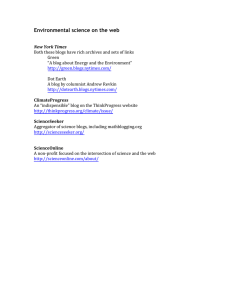
Users’ Behavioral Analysis on Weblogs
Tadanobu Furukawa
Yutaka Matsuo
Information Technology Research Institute,
Tokyo University of Science
Yamazaki 2641, Chiba 278-8510, Japan
tektf@mt.is.noda.tus.ac.jp
National Institute of Advanced Industrial
Science and Technology (AIST)
Sotokanda 1-18-13, Tokyo 101-0021, Japan
y.matsuo@aist.go.jp
Tomofumi Matsuzawa and Masayuki Takeda
Koki Uchiyama
Dept. of Information Sciences,
Tokyo University of Science
Yamazaki 2641, Chiba 278-8510, Japan
{t-matsu, takeda}@is.noda.tus.ac.jp
Hottolink, Inc.
Nishigotanda 2-11-17, Tokyo 141-0031, Japan
uchi@hottolink.co.jp
Abstract
This study investigates Weblog users’ behavioral data
on a hosting service in Japan. The study analyzes users’
behaviors, such as browsing and bookmarking, in addition to posting comments and sending trackbacks. Results of this study reveal the causes of a user’s visiting
and regularly browsing behaviors, especially from a social network point of view. The correlation between the
strength of two users on the social network and their
visiting behavior is analyzed.
Introduction
Web logs (blogs) are receiving much attention as a new
medium to describe individual experiences and opinions.
Blog users sometimes visit others’ blogs and write comments or send trackbacks as they update their own blogs.
These users’ behaviors result in relationships among blogs,
which create interesting data for analyses of blog communities and topic diffusion. Recently, users have come to
read blogs using RSS readers and social networking services
(SNSs). We can assume that a user might use social networks to seek blogs.
Our analyses use the database of a blog-hosting service in
Japan called Doblog1 , which NTT Data Corp. and hottolink,
Inc. provided. Using this service, users can create and update their blogs easily. They write their blogs, change the
templates, and write comments after they log in. Therefore,
we can monitor users’ behavior in great detail, even information showing which blogs a user has browsed and when.
Doblog has a special function called “bookmark” to link to
favorite blogs from one’s own blog. We regard the bookc 2006, American Association for Artificial IntelliCopyright °
gence (www.aaai.org). All rights reserved.
1
c
c
°NTT
Data Corp., °hottolink,Inc.,
http://www.doblog.com/ , using data of Oct. 2003 – Jul. 2004
mark information as representative of browser bookmarks
or blogs of a user’s RSS reader.
This study analyzes users’ behaviors from a social network point of view. Three types of relationship are considered: comment, trackback, and bookmark. We call these
relationships blog-based relationships. Two types of behavioral relationships considered in this study are: Visit and
Regular Reading. We clarify how the blog-based relationship affects users’ behaviors. Mainly, two questions are investigated: Do users’ blog-based relationships affect their
browsing behavior? Furthermore, can we predict whether
users visit or read a certain blog frequently based on blogbased relation information?
Relations between two Blogs
Three types of blog-based relations, Comment, Trackback,
and Bookmark, are defined as follows: If user UA , who
writes blog A, comments on or trackbacks to blog B, we define a relation of Comment / Trackback from A to B. If user
UA registers blog B as a bookmark in the Doblog system,
we define a relation of Bookmark from A to B.
We also define a user’s browsing behavior. If user UA
browses B, we call it Visiting behavior from A to B2 ; if user
A has visited user B’s blog regularly, which is defined in this
paper as more than 30 times, we call it Regular Reading
behavior from A to B.
Our hypothesis is that users’ (indirect) relationships affect users’ browsing behavior. Therefore, (i) What relations
among Comment, Trackback, and Bookmark behaviors engender Visiting behavior and Regular Reading behavior?
We analyzed data of 1647 blogs with top frequent users,
who are 10% of all Doblog users. The data consist of 59% of
2
To exclude an unintended browse, we define Visit as the relation by which a user browses more than once. Comment and
Trackback relations are defined similarly.
all Bookmark data, 64% Comment data, and 64% Trackback
data.
120
100
Bookmark
Two blogs sometimes have numerous relations. Because two
blogs’ direct relations are explicit and readily apparent, we
specifically examine indirect relations between two blogs.
A measure of each relational strength is represented by the
number of routes that connect two blogs in two hops with the
same direction. For example, three routes exist between A
and B, as shown in Fig. 1. We can also consider two blogs
that are connected by three or more hops, but that relation
should be less effective. Moreover, in sociological studies, a
two-hop relation is sometimes assessed, e.g., transitivity and
clustering coefficients. For that reason, we examine only the
number of routes in two hops.
Figure 2 shows the extent to which the rate follows the
transitivity rule in these two hops. This figure reveals a positive correlation between the number of routes and the transitivity rule.
Number of Routes
of A→B is 3
blog 1
blog 2
Blog B
(starting point)
(terminal point)
blog 3
Blog A
Visiting Rate (%)
Relations among two blogs
80
Comment
60
Trackback
40
Interest
20
0
0
10
20
30
40
50
60
Strength of Relation (number of routes / same interests)
Figure 3: Number of link routes or similarity of interest and
Visiting
blog is 80%. Bookmark and trackback relations more effectively induce users to visit. The reason seems to be that the
Bookmarks, Comments, and Trackbacks create a hyperlink
that allows a user to visit the site easily. No correlation can
be found between the number of fields of identical interest
and visiting behavior: Doblog allows users to register their
interests categorically, which does not contribute to explain
the users’ behaviour.
Blog C
or
or
Bookmark
Comment
Trackback
blog 4
User behavior prediction
blog 5
What causes users to visit other persons’ blogs? What relation most affects daily browsing behavior? If we can create
a model and predict whether a user will like a blog or not,
we can build a recommendation list of blogs for each user.
Below, a classifier to predict a user’s browsing behavior is
produced using a machine learning technique.
&
&
&
Bookmark
Comment
Trackback
Figure 1: Number of routes
BMK
CMT
TB
BMK
120
BMK
(starting point)
CMT
CMT
(terminal point)
TB
100
Rate of Transitivity Rule (%)
Blog A
Bookmark
TB
BMK
80
CMT
TB
Comment
60
40
Trackback
Figure 4: 12 kinds of relations. (BMK, Bookmark; CMT,
Comment; TB, Trackback)
20
0
0
10
20
30
40
50
60
Number of Routes
Figure 2: Number of routes and the transitivity rule
Figure 3 shows the visiting rate versus the number of
routes. For example, if there are 20 routes of two-hop comment relations, the probability of that user visiting another’s
As Fig. 4 shows, 12 kinds of relation are considered in
the range of two-hop relations (represented as gray nodes in
the figure). For all two-blog sets (1647 P2 sets), we checked
which relations among the 12 kinds of relations existed, and
whether they have a Visiting / Regular Reading relation.
Using each set as training data, we analyzed which relation determines Regular Reading behavior. Then we constructed a decision tree using a machine learning algorithm
C4.5.During Visiting analysis, we excluded blog sets with a
one-hop relation because there must be a Visiting behavior.
B : Bookmark
C : Comment
T : Trackback
TT
false
Table 1: Form of training data for analyses of relation types
CT
12 Types of Relation
Bmk Cmt
...
Tb-Tb
T
F
...
T
F
T
...
F
T
T
...
T
.
.
.
Vst
(Rd)
T
F
T
.
.
.
CB
true
false
2 blogs
start term
A
B
A
C
B
C
.
.
.
true
BT
TC
false true
No (71%)
77%
false
Yes (66%)
1.8%
TB
false true
false true
Yes (58%)
0.7%
BB
true
Yes (70%)
2.3%
BB
false true
TC
TB
false
Yes (61%)
0.6%
true
CC
CT
false true
false true
BC
CC
TC
Yes (66%)
0.3%
100
Regular Reading Rate (%)
90
Bookmark
80
Figure 6: Decision tree of Visiting by 12 kinds of relations
false
Comment
60
40
Trackback
30
C
true
No (98%)
80%
Interest
10
false
true
No (94%)
1.0%
C
false
20
true
B
false
50
B : Bookmark
C : Comment
T : Trackback
T
70
true
No (93%)
7.5%
B
false
No (71%)
1.4%
TC
true
Yes (68%)
2.3%
false true
0
0
10
20
30
40
50
60
CT
BT
Strength of Relation (number of routes / same interests)
Figure 5: Number of link routes or similarity of interest &
Regular Reading (more than 30 visits)
Figure 7: Decision tree of Regular Reading by 19 kinds of
relations
For Visiting analysis, the training data were 568,046 sets
of two blogs that have more than one route by any two-hop
relation. For Regular Reading analysis, 154,549 sets of two
blogs have a Visiting relation. Each data set for machine
learning consists of the number of routes of each relation
and whether a Visiting or Regular Reading relation exists
(Table 1).
Performance of the prediction method is shown in Table
2. The recall is not high, implying that it is difficult to infer all the blogs that a user visits or regularly reads because
there might be numerous reasons to read blogs. However,
the precision is high: if a user is in a certain (two-hop) relation to a blog, a user is likely to visit or regularly read it.
Therefore, we can reasonably recommend blogs that are predicted to have a visit or regular read relation, but which have
not yet been actually visited or regularly read by the user.
Figures 6 and 7 respectively show decision trees for Visit
and Regular Reading. In those decision trees, the highly
influential relation occupies the upper position as a node,
and B / C / T represents Bookmark / Comment / Trackback.
The leaves show “Yes” or “No”, representing whether the
Visiting or Regular Reading relation is true or false. The
Bookmark relation has a strong effect, but Comment is also
a good index for prediction. The Comment relation implies
a similarity of interests. Therefore, it is used for prediction.
Table 2: Recall and Precision
Recall Precision Error
Visit
0.152
0.633
0.310
Regular reading 0.314
0.666
0.059
Conclusions
This study explored unique relations among users’ behaviors
on a blog network in which blog users visit and regularly
read the materials. We analyzed the relation between the
network and user behaviors, and also tried to predict whether
users visit or read a certain blog frequently based on the relation information. We consider that the further analysis can
form the basis of an recommendation service of blogs.
References
Adar, E.; and Adamic, L.A. 2004. Tracking Information
Epidemics in Blogspace. Workshop on the Weblogging
Ecosystem, 14th International World Wide Web Conference.
Glance, N.; Hurst, M.; and Tomokiyo, T. 2004. BlogPulse:
Automated Trend Discovery for Weblogs. Workshop on
the Weblogging Ecosystem, 13th International World Wide
Web Conference.
Kumar, R.; Novak, J.; Raghavan, P.; and Tomkins, A. 2003.
On the Bursty Evolution of Blogspace. The 10th International World Wide Web Conference.




